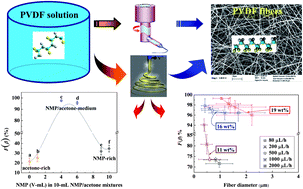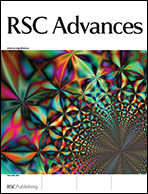Spectroscopic evidence for a high fraction of ferroelectric phase induced in electrospun polyvinylidene fluoride fibers†
Abstract
Effective transformation from paraelectric to a high fraction of ferroelectric phase is crucial to produce piezoelectric materials with a high piezoelectric constant for broad applications. In polyvinylidene fluoride (PVDF) thin films, both mechanical stretching and electric poling processes have been found to be critical in the α → β phase transformation. However, in PVDF fibers fabricated by the electrospinning process, the roles of mechanical stretching and electric poling have not been well explored. Here, the properties of PVDF fibers from electrospinning and forcespinning, a mechanical spinning process without electric poling, have been characterized and analyzed by FTIR and XRD spectroscopic techniques. The results show that pure mechanical stretching in the forcespun fibers can result in a high fraction of the all-trans β-phase, at 95%. Electrospun fibers from the same material system, on the other hand, can also reach a high fraction of β-phase, at approximately 99%. These results preliminarily demonstrate that mechanical stretching is the main reason for β-phase induction in PVDF fibers. Further experiments performed in this work show that higher wt% of PVDF, lower polymer solution supply rate, and more uniformly mixed solvent systems facilitate achieving a higher level of ferroelectric β-phase in electrospun PVDF fibers.


 Please wait while we load your content...
Please wait while we load your content...